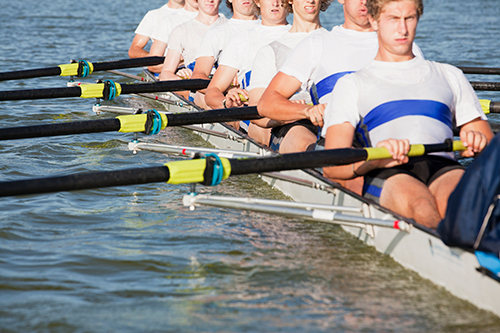![Tapping into the microbiome of athletes, scientists have identified bacteria that may aid athletic performance. [Clerkenwell/Getty Images]](https://genengnews.com/wp-content/uploads/2018/08/Aug21_2017_Getty_129179570_MenOaringCanoe_5002541421318-1.jpg)
Tapping into the microbiome of athletes, scientists have identified bacteria that may aid athletic performance. [Clerkenwell/Getty Images]
No guts, no glory is often a mantra that top athletes ascribe to when trying to excel in their respective sport. However now, researchers from George Church’s laboratory at Harvard Medical School along with investigators at Wyss Institute for Biologically Inspired Engineering at Harvard have begun to chant the same adage, but for a wholly different reason. The scientists developed the idea of surveying the gut microbiota of elite athletes to determine if they have a natural edge from the bacteria that inhabit their digestive tracts. Amazingly, while studying the microbiome from exceptional runners and rowers, the research team identified bacteria that may aid athletic performance.
Data from this new study was presented recently at the 254th National Meeting & Exposition of the American Chemical Society (ACS) in an article entitled “FitBiomics: Understanding Elite Microbiomes for Performance and Recovery Applications.” The goal is to develop probiotic supplements that may help athletes—and even amateur fitness enthusiasts—recover from a tough workout or more efficiently convert nutrients to energy.
“When we first started thinking about this, I was asked whether we could use genomics to predict the next Michael Jordan,” noted senior study investigator Jonathan Scheiman, Ph.D., a research fellow the Wyss Institute. “But my response was that a better question is: Can you extract Jordan's biology and give it to others to help make the next Michael Jordan?”
Naturally, the microbiome, specifically within the intestinal tract, seemed the most appropriate place for the investigators to begin the quest.
“We are more bacteria than we are human,” explained Dr. Scheiman. “The bugs in our gut affect our energy metabolism, making it easier to breakdown carbohydrates, protein, and fiber. They are also involved in inflammation and neurological function. So perhaps the microbiome could be relevant for applications in endurance, recovery and maybe even mental toughness.”
Unglamorously, the research team collected fecal samples on a daily basis from 20 athletes training for the 2015 Boston marathon, one week before and one week after the race.
“For two weeks, I was driving around Boston collecting fecal samples and putting them on dry ice in the car,” Dr. Scheiman remarked. “We followed athletes longitudinally to capture how the microbiome changes between performance and recovery.”
Consequently, the researchers sequenced the genomes of the sampled bacteria, using computational metagenomic methods to figure out how many and what types of microbes inhabited the fecal samples. When they compared the pre-race and post-race samples, the researchers found a sudden spike in the population of one particular type of bacteria after the marathon. During intense exercise, the body produces more lactic acid than usual, which can lead to muscle fatigue and soreness. This bacterium could potentially help with that. “This bug's natural function is to breakdown lactic acid,” Dr. Scheiman added.
The researchers isolated the bacterium from fecal samples and are beginning to evaluate its properties. They've already determined that the bug excels at breaking down lactic acid in a test tube and remains viable after it passes through the digestive system of mice. The researchers are now feeding the bacterium to mice to measure its effects on lactic acid levels and fatigue.
Additionally, the investigators are comparing the bacteria from ultramarathoners to those found in rowers training for the Olympics. They found a type of bacteria in ultramarathoners that can help breakdown carbohydrates and fiber—which is key during a 100-mile run—that wasn't present in the rowers, suggesting that different sports may foster niche microbiomes.
The researchers were excited by their findings, so much so that Dr. Scheiman is currently involved in launching a company, called Fitbiomics, with the intent of studying a vast array of microbiomes and provide insight into healthy and unhealthy guts.
“I would like to think that a year after we launch, we could have a novel probiotic on the market,” Dr. Scheiman concluded. “But in parallel, we'll also be expanding our cohort of elite athletes from numerous sports to generate a larger microbial data and strain bank of novel probiotic candidates. In essence, we're mining the biology of the fittest and healthy people in the world and then extracting that information to help them and others.”



